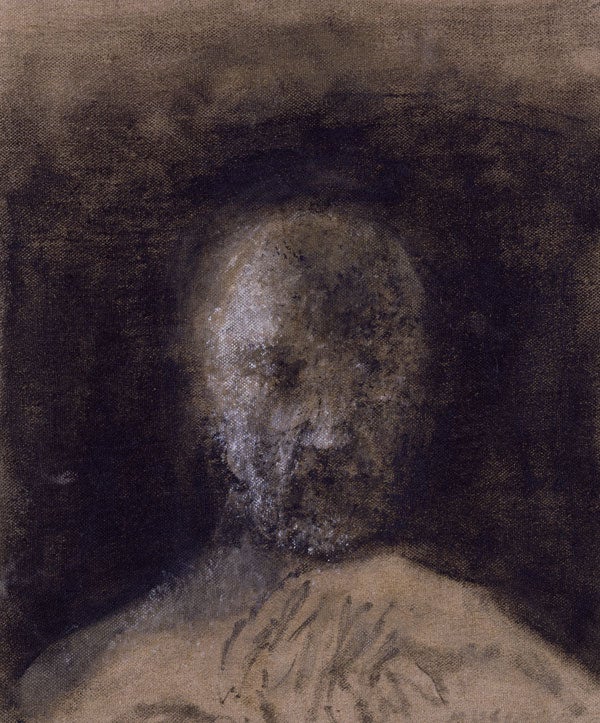Great works: Self-Portrait 1990 (48x38 cms), Zoran Music
Robert and Lisa Sainsbury Collection

So many of the later paintings and drawings of the Slovenian painter and Dachau-survivor Zoran Music seem to be a near perfect distillation of tragedy and suffering. Unlike in the case of so many artists, he seems not to have chosen these subjects. They, rather, have chosen him. They have tapped him on the shoulder and said: this is what you must do. And he has done it. They are not so much subjects as visions that have swum up from the depths, images which he has not been able to ignore or turn away from. He is the conduit of a certain tragic vision, an unwilling chronicler of all that he witnessed during his incarceration. Although he was a man of Mitteleuropa, he preferred to regard himself as a person of no fixed abode, to identify himself with the idea of the exile or the wanderer.
When Music works with the figure, the result is often as much general as particular, a portrait of humankind as much as an image that captures the likeness of a particular man or woman. We recognise this to be true in this Self-Portrait of 1990. Although the face and the features are fairly well defined (there is no doubting the texture of that grizzled beard), there is also, we feel, a drawing back, and even a turning away from, too scrupulous a definition of any particular individual. It is both a particular portrait of himself and an essentialised portrait of the burden of what he represents to himself, and in so doing it pares portraiture back to the bone. The head has some depth and perspective, fullness, roundedness, but the rest of the image does not – quite deliberately so. The head is surrounded by a black void of unknowing. It is also lit from the right by a kind of unearthly silvery sheen, as if the head, that lonely object, long incarcerated, has, all of a sudden, been startled into a reminder of its own existence by a flood of unearthly light. That head seems to be afloat against nothing, and even be to be a ghostly reminder of the one borne by Salomé on a platter. There is no context of any kind. Why does this head looks so massive and so heavy? Everything that it remembers is bearing down upon it from all sides. By contrast, the torso and the arm are rendered extremely crudely, thinly, flatly, as if Music has quickly become impatient with the idea of modelling in the round. All this thin rendering makes the modelled head look, by contrast, a touch preposterous, as if it is claiming too much humanity for itself by being so fully and monumentally shaped. The fact is, perhaps, that it doesn't quite deserve such care – this is surely the point that the painter is making. It deserves to be treated, like torso and arm, with a sense of hurry and disrespect – so much sketchy dross to be tossed into the pit. The truth of that arm, which seems to rise up below the head like the mechanised arm of a crane, is in its scratchy, provisional, almost spidery meagreness. If anything, it seems to menace and threaten the head, to be at odds with all that monumental stillness.
We could not readily recognise the tradition from which this painting has emerged. Nor the year when it was painted. Can this really have been made in 1990? It feels years distant from any notion of modernity. It is attached to no particular time and no particular place. It looks a little like an ancient icon, somewhat Byzantine in feeling.
A little like a Velasquez, too. We feel that the painter does not really want it to look timely. After all, human suffering is timeless.
ABOUT THE ARTIST
The Slovenian painter Zoran Music (1909-2005) was interned towards the end of the Second World War by the gestapo after showing, in the opinion of his captors, an unusual degree of sympathy for the activities of the Italian Resistance. His work changed fundamentally in the 1970s, when it became increasingly haunted by images of the dead and the dying from those terrible years.
Subscribe to Independent Premium to bookmark this article
Want to bookmark your favourite articles and stories to read or reference later? Start your Independent Premium subscription today.

Join our commenting forum
Join thought-provoking conversations, follow other Independent readers and see their replies